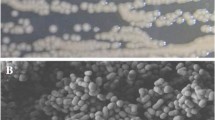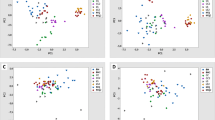Abstract
This study investigates the diversity and the potential phosphorus-accumulating ability among the purple nonsulfur (PNS) bacteria. Traditional methods and molecular biotechniques were applied. Microscopic visualization using 4′,6-diamidino-2-phenylindole staining as well as chemical analysis demonstrated that most of the isolated PNS bacteria presented different levels of phosphorus accumulation. Four of the pure cultures, denoted as Rhodopseudomonas palustris CC1, CC7, G11, and GE1, based on their differences in the PNS’s pufM gene, exhibited higher internal phosphorus content compared to other isolated strains in this study. In addition, substantial polyphosphate accumulation was observed after the bacteria entered their stationary growth phase. Among them, the isolated R. palustris G11 could accumulate internal phosphorus up to 13%–15% of its cell dry weight under anaerobic illuminated incubation conditions. When the incubation status was switched from anaerobic to aerobic, the bacterial phosphorus content had a tendency to decrease slightly or remain about the same throughout the whole aerobic stage. The growth rate and biomass were higher when the PNS bacteria grew under photoheterotrophic conditions rather than the chemoheterotrophic ones. Furthermore, the environmental pH value could affect the contents of internal bacterial phosphate. Results of this study demonstrated that PNS bacteria are a group of the polyphosphate-accumulating organisms, of which this ability had never been properly studied. The conditions that PNS bacteria accumulating polyphosphate presented from this study were unique and showed characteristics that were different from the well-known enhanced biological phosphorus removal model.





Similar content being viewed by others
References
Achenbach LA, Carey J, Madigan MT (2001) Photosynthetic and phylogenetic primers for detection of anoxygenic phototrophs in natural environments. Appl Environ Microbiol 67:2922–2926
Akiyama M, Crooke E, Korngerg A (1992) The polyphosphate kinase gene of Escherichia coli—isolation and sequence of the ppk gene and membrane location of the protein. J Biol Chem 267:22556–22561
Altschul SF, Gish W, Miller W, Myers EW, Lipman DJ (1990) Basic local alignment search tool. J Mol Biol 215:403–410
Bental M, Pick U, Avron M, Degani H (1991) Polyphosphate metabolism in the alga Dunaliella salina studied by 31P-NMR. Biochem Biophys Acta 1092:21–28
Bond P, Hugenholtz P, Keller J, Blackall L (1995) Bacterial community structures of phosphate-removing and non-phosphate-removing activated sludges from sequencing batch reactors. Appl Environ Microbiol 61:1910–1916
Bond PL, Erhart R, Wagner M, Keller J, Blackall LL (1999) Identification of some of the major groups of bacteria in efficient and nonefficient biological phosphorus removal activated sludge systems. Appl Environ Microbiol 65:4077–4084
Carlozzi P, Sacchi A (2001) Biomass production and studies on Rhodopseudomonas palustris grown in an outdoor, temperature controlled, underwater tubular photobioreactor. J Biotechnol 88:239–249
Castro CD, Meehan AJ, Koretsky AP, Domach MM (1995) In situ 31P nuclear magnetic resonance ofr observation of polyphosphate and catabolite responses of chemostat-cultivated Saccharomyces cerevisiae after alkalinization. Appl Environ Microbiol 61:4448–4453
Comeau Y, Hall KJ, Hancock REW, Oldham WK (1986) Biological model for enhanced biological phosphorus removal. Water Res 20:1511–1182
Crocetti GR, Hugenholtz P, Bond PL, Schuler A, Keller J, Jenkins D, Blackall LL (2000) Identification of polyphosphate-accumulating organisms and design of 16S rRNA-directed probes for their detection and quantitation. Appl Environ Microbiol 66:1175–1182
Dawes EA, Senior PJ (1973) Energy reserve polymers in microorganisms. Adv Microb Physiol 10:178–203
Eaton AD, Clesceri LS, Greenberg AE (1995) Standard methods for the examination of water and wastewater. American Public Health Association, Washington
Fuhs GW, Chen M (1975) Microbiological basis of phosphate removal in the activated sludge process for the treatment of wastewater. Microb Ecol 2:119–138
Hesselmann RPX, Werlen C, Hahn D, van der Meer JR, Zehnder AJB (1999) Enrichment, phylogenetic analysis and detection of a bacterium that performs enhanced biological phosphate removal in activated sludge. Syst Appl Microbiol 22:454–465
Hiraishi A, Kitamura H (1985) Changes in the polyphosphate content of photosynthetically grown Rhodobacter sphaeroides due to nutrient limitation. Agric Biol Chem 49:3343–3345
Izu K, Nakajima F, Yamamoto K, Kurisu F (2001) Aeration conditions affecting growth of purple nonsulfur bacteria in an organic wastewater treatment process. Syst Appl Microbiol 24:294–302
Kato J, Yamamoto T, Yamada K, Ohtake H (1993) Cloning, sequence and characterization of the polyphosphate kinase-encoding gene (ppk) of Kesbsilla aerogenes. Gene 137:242
Kolber M, Van Dover CL, Niederman RA, Faalkowsji PG (2000) Bacterial photosynthesis in surface waters of the open ocean. Nature 407:177–179
Kong Y, Nielsen JL, Nielsen PH (2004) Microautoradiographic study of Rhodocyclus-related polyphosphate-accumulating bacteria in full-scale enhanced biological phosphorus removal plants. Appl Environ Microbial 70:5383–5390
Kulaev IS, Vagabov VM (1983) Polyphosphate metabolism in microorganisms. Adv Microbiol Physiol 15:731–738
Kulaev IS, Vagabov VM, Kulakovskaya TV (1999) New aspects of inorganic polyphosphate metabolism and function. J Biosci Bioeng 88:111–129
Liu WT, Nielsen AT, Wu JH, Tsai CS, Matsuo Y, Molin S (2001) In situ identification of polyphosphate- and polyhydroxyalkanoate-accumualting traits for microbial populations in a biological phosphorus removal process. Environ Microbiol 3:110–122
Madigan MT (1988) Microbiology, physiology, and ecology of phototrophic bacteria. Wiley, New York
Madigan MT, Martinko JM, Parker J (2006) Brock biology of microorganisms. Prentice Hall, Englewood Cliffs
Margaritis A, Vogrinets J (1983) The effect of glucose concentration and pH on hydrogen production by Rhodopseudomonas sphaeroides VM81. Int J Hydrogen Energy 8:281–294
Maszenan AM, Seviour RJ, Patel BKC, Schumann P, Burghardt J, Tokiwa Y, Stratton HM (2000) Three isolates of novel polyphosphate-accumulating gram-positive cocci, obtained from activated sludge, belong to a new genus, Tetrasphaera gen, nov., and description of two new species, Tetrasphaera japonica sp, nov and Tetrasphaera australiensis sp nov. Int J Syst Evol Microbiol 50:593–603
Mino T, VanLoosdrecht MCM, Heijnen JJ (1998) Microbiology and biochemistry of the enhanced biological phosphate removal process. Water Res 32:3139–3207
Mullan A, Quinn JP, McGrath JW (2002) Enhanced phosphorus uptake and polyphosphate accumulation in Burkholderia cepacia grown under low-pH conditions. Microb Ecol 44:69–77
Myer J, Kelley BC, Vignais PM (1978) Effect of light on nitrogenase function and synthesis in Rhodopseudomonas capsulate. J Bacteriol 201–208
Nakamura K, Hiraishi A, Yoshimi Y, Kawaharasaki M, Masuda K, Kamagata Y (1995) Microlunatus phosphorus gen. nov., sp. nov., a new gram-positive polyphosphate-accumulating bacterium isolated from activated sludge. Int J Syst Bacteriol 45:17–22
Ohtake H, Takahashi K, Tsuzuki Y, Toda K (1985) Uptake and release of phosphate by a pure culture of Acinetobacter calcoaceticus. Water Res 19:1587–1594
Peng YP, Stevens P, DeVos P, DeLey J (1978) Relation between pH, hydrogenase and nitrogenase activity, NH +4 concentration and hydrogen production in culture of Rhodobacter sulfidophilus. J Gen Microbiol 133:1243–1247
Pfennig N (1978) Rhodocyclus purpureus gen. nov. and sp. nov., a ring-shaped vitamin b12-requiring member of the family Rhodospirillaceae. Int J Syst Bacteriol 28:283–288
Pick U, Weiss M (1991) Polyphosphate hydrolysis within acidic vacuoles in response to amine-induced alkaline stress in the halotolerant alga Dunaliella salina. Plant Physiol 97:1234–1240
Pick U, Bental M, Chitlaru E, Weiss M (1990) Polyphosphate-hydrolysis—a protective mechanism against alkaline stress. FEBS 274:15–18
Santos MM, Lemos PC, Reis MAM, Santos H (1999) Glucose metabolism and kinetics of phosphorus removal by the fermentative bacterium Microlunatus phosphovorus. Appl Environ Microbiol 65:3920–3928
Sasikala K, Ramana CV, Rao PR (1991) Environmental regulation for optimal biomass yield and photoproduction of hydrogen by Rhodobacter sphaeroides O.U.001*. J Hydrogen Energ 16:597–601
Saunders AM, Oehmen A, Blackall LL, Yuan Z, Keller J (2003) The effect of GAOs (glycogen accumulating organisms) on anaerobic carbon requirements in full-scale Australian EBPR (enhanced biological phosphorus removal) plants. Water Sci Technol 47:37–43
Seufferheld MJ, Alvarez HM, Farias ME (2008) Role of polyphosphate in microbial adaptation to extreme environments. Appl Environ Microbiol 74:5867–5874
Shoda M, Ohsumi T, Udaka S (1980) Screening for high phosphate accumulating bacteria. Agric Biol Chem Tokyo 4:319–324
Stante L, Cellamare CM, Malaspina F, Bortone G, Tilche A (1997) Biological phosphorus removal by pure culture of Lampropedia spp. Water Res 31:1317–1324
Tamura K, Dudley J, Nei M, Kumar S (2007) MEGA4: molecular evolutionary genetics analysis (MEGA) software version 4.0. Mol Biol Evol 24:1596–1599
Tinsley CR, Gotschlich EC (1995) Cloning and characterization of the meningococcal polyphosphate kinase gene—production of the polyphosphate synthesis mutants. Infect Immun 63:1624–1630
Tobin KM, McGrath JW, Mullan A, Quinn JP, O’Connor KE (2007) Polyphosphate accumulation by Pseudomonas putida CA-3 and other medium-chain-length polyhydroxyalkanoate-accumulating bacteria under aerobic growth conditions. Appl Environ Microbial 73:1383–1387
Uyar B, Eroglu I, Yücel M, Gündüz U, Türker L (2007) Effect of light, wavelength and illumination protocol on hydrogen production in photobioreactors. Int J Hydrogen Energy 36:4670–4677
Zajic JE, Kosaric N, Brosseau JD (1978) Microbial production of hydrogen. Adv Biochem Eng 9:57–109
Zilles JL, Peccia J, Kim MW, Hung CH, Noguera DR (2002) Involvement of Rhodocyclus-related organisms in phosphorus removal in full-scale wastewater treatment plants. Appl Environ Microbiol 68:2763–2769
Author information
Authors and Affiliations
Corresponding author
Rights and permissions
About this article
Cite this article
Liang, CM., Hung, CH., Hsu, SC. et al. Purple nonsulfur bacteria diversity in activated sludge and its potential phosphorus-accumulating ability under different cultivation conditions. Appl Microbiol Biotechnol 86, 709–719 (2010). https://doi.org/10.1007/s00253-009-2348-2
Received:
Revised:
Accepted:
Published:
Issue Date:
DOI: https://doi.org/10.1007/s00253-009-2348-2




